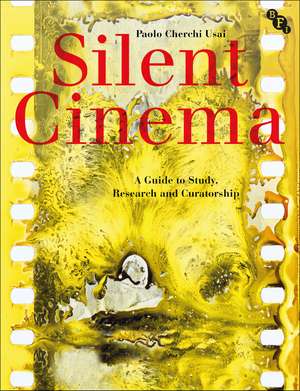Silent Cinema: A Guide to Study, Research and Curatorship
Autor Paolo Cherchi Usaien Limba Engleză Paperback – 3 apr 2019
| Toate formatele și edițiile | Preț | Express |
|---|---|---|
| Paperback (1) | 236.07 lei 3-5 săpt. | |
| Bloomsbury Publishing – 3 apr 2019 | 236.07 lei 3-5 săpt. | |
| Hardback (1) | 725.73 lei 3-5 săpt. | |
| Bloomsbury Publishing – 3 apr 2019 | 725.73 lei 3-5 săpt. |
Preț: 236.07 lei
Preț vechi: 265.09 lei
-11% Nou
Puncte Express: 354
Preț estimativ în valută:
45.18€ • 46.99$ • 37.30£
45.18€ • 46.99$ • 37.30£
Carte disponibilă
Livrare economică 22 martie-05 aprilie
Preluare comenzi: 021 569.72.76
Specificații
ISBN-13: 9781844575282
ISBN-10: 1844575284
Pagini: 448
Ilustrații: 98 colour; 229 bw illus
Dimensiuni: 189 x 246 x 16 mm
Greutate: 0.93 kg
Ediția:3
Editura: Bloomsbury Publishing
Colecția British Film Institute
Locul publicării:London, United Kingdom
ISBN-10: 1844575284
Pagini: 448
Ilustrații: 98 colour; 229 bw illus
Dimensiuni: 189 x 246 x 16 mm
Greutate: 0.93 kg
Ediția:3
Editura: Bloomsbury Publishing
Colecția British Film Institute
Locul publicării:London, United Kingdom
Caracteristici
Written by a leading expert in the field, internationally recognised for his work in film preservation and the critical understanding of silent cinema
Notă biografică
Paolo Cherchi Usai is Senior Curator of the Motion Picture Department of George Eastman House, founder of the L. Jeffrey Selznick School of Film Preservation and of the annual Pordenone Silent Film Festival. Cherchi Usai's publications include The Griffith Project, co-published by the British Film Institute and Le Giornate del Cinema Muto, in 12 volumes (1996-2012); The Death of Cinema: History, Cultural Memory, and the Digital Dark Age (2001); and Burning Passions: An Introduction to the Study of Silent Cinema (1994).
Cuprins
Preface to the Third EditionAcknowledgementsNoteIntroductionChapter 1 - PixelsChapter 2 - CelluloidChapter 3 - ChromaChapter 4 - MachinesChapter 5 - PeopleChapter 6 - BuildingsChapter 7 - WorksChapter 8 - ShowChapter 9 - AcousticsChapter 10 - CollectionsChapter 11 - EvidenceChapter 12 - DuplicatesChapter 13 - LacunaeChapter 14 - TracesChapter 15 - CuratorshipBibliographic resources and research toolsAppendix 1 - Film Measurement TablesAppendix 2 - Eastman Kodak Edge Codes on Motion Picture Film Stock, 1913-1928Appendix 3 - Identification of Pathé Films by Their Edge InscriptionsCredits of IllustrationsIndexAbout the author
Recenzii
Silent Cinema is a must-have book for everyone interested in cinema of all eras . If you're not a silent fan, this giddy ride can make you one.
Paolo Cherchi Usai, renowned film curator, filmmaker, and programmer, has created an engaging saga of the diverse ways in which people have made films-and rescued them for others to enjoy. Silent Cinema is a rare feast of information, ideas, and insights. Using Méliès' moon-shot as a recurring example, Cherchi Usai surveys everything from perforations and acting performances to musical accompaniment, each treated with clarity and wit. Particularly valuable are the nuanced accounts of how digital technology has transformed our attitudes toward silent films. The reader comes away with a deeper appreciation of the patient curators who have dedicated themselves to making 'old cinema' perpetually new.
For decades, Paolo Cherchi Usai's book had been a definitive and inspiring guide to silent cinema-and stays so today when this formerly out-of-the-way and obscure field of study has entered the realm of mainstream entertainment. It stays so because Cherchi Usai has kept it up to date-by way of questioning rather than going along with contemporary dogmas and illusions. Silent film was a performative rather than a technologically reproductive medium; digitization of the photochemical is a deadly remedy instead of a hoped-for panacea. No stone unturned. I fully endorse Paolo Cherchi Usai's daringly cautionary guide.
This third edition of an already classic introduction to cinema's 'silent' era may be the best of all. Instead of merely updating his pioneering text, Paolo Cherchi Usai has re-thought what the early period means to us today, and addresses the 'digital natives' who will be its main readers. It's hard to imagine a more enthusiastic or authoritative introduction.
Paolo Cherchi Usai, renowned film curator, filmmaker, and programmer, has created an engaging saga of the diverse ways in which people have made films-and rescued them for others to enjoy. Silent Cinema is a rare feast of information, ideas, and insights. Using Méliès' moon-shot as a recurring example, Cherchi Usai surveys everything from perforations and acting performances to musical accompaniment, each treated with clarity and wit. Particularly valuable are the nuanced accounts of how digital technology has transformed our attitudes toward silent films. The reader comes away with a deeper appreciation of the patient curators who have dedicated themselves to making 'old cinema' perpetually new.
For decades, Paolo Cherchi Usai's book had been a definitive and inspiring guide to silent cinema-and stays so today when this formerly out-of-the-way and obscure field of study has entered the realm of mainstream entertainment. It stays so because Cherchi Usai has kept it up to date-by way of questioning rather than going along with contemporary dogmas and illusions. Silent film was a performative rather than a technologically reproductive medium; digitization of the photochemical is a deadly remedy instead of a hoped-for panacea. No stone unturned. I fully endorse Paolo Cherchi Usai's daringly cautionary guide.
This third edition of an already classic introduction to cinema's 'silent' era may be the best of all. Instead of merely updating his pioneering text, Paolo Cherchi Usai has re-thought what the early period means to us today, and addresses the 'digital natives' who will be its main readers. It's hard to imagine a more enthusiastic or authoritative introduction.
